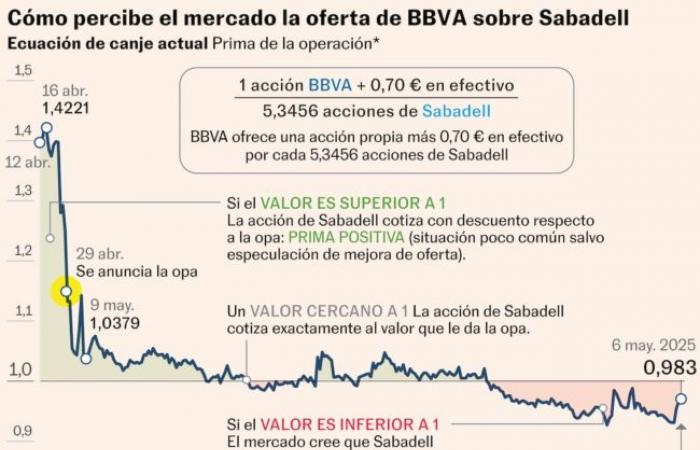
The hostile OPA launched by the BBVA to take over the Sabadell enters a critical phase. Although the National Commission of Markets and Competition (CNMC) has given the green light to the operation, after imposing measures destined to safeguard the competition, analysts warn that the bank still has two major fronts that will define the success or failure of the operation: the final opinion of the government and the acceptance of the Sabadell shareholders.
In the regulatory level, the government must decide whether it is limited to supporting the favorable competition report or if it raises the matter to the Council of Ministers. This last option would open an additional period of 30 days to review the operation and evaluate whether it imposes new conditions. And here, analysts warn that an attempt by the Executive for even more hardening these conditions could threaten the financial lace of the operation.
“The news of the last week suggests that there is now a greater probability that this agreement is not completed due to government interference,” he explains to Fifodies Benjamin Toms, Director of RBC Variable Analysis of Capital Markets. “Although the remedies [compromisos] Required by the CNMC, the synergies that BBVA expects to generate with the operation, the bank felt comfortable with these measures have slightly reduced. It is not clear to us how the government can be based on public interest as the basis for imposing new conditions. But it is likely that stricter measures are considered unacceptable for both the company and the market, and depending on its reach, they could mean that the operation ceases to make financial sense. In addition, it would send a sign that later the government may not approve the legal fusion of both entities, ”he warns.
The conditions approved by the CNMC already suppose an important effort for BBVA. They focus, on general, to guarantee financial inclusion and protection of vulnerable clients, on maintaining current credit and conditions for SMEs and freelancers and avoiding offices closures in areas with low competition or low per capita income. These commitments will affect the synergies (the savings that the merger would generate) that BBVA initially estimated at 850 million euros. With the new conditions, the Kepler Cheuvreux firm calculates that they could be reduced by one third, to 590 million. Although most analysts continue to consider that the operation maintains its business and strategic logic, they also warn that the new measures that harden them would erode the financial attraction.
The operation remains in a delicate equilibrium game. While waiting for the government’s decision, BBVA must convince Sabadell’s shareholders that their offer to unite both banks is more attractive than navigating alone. But this front is not insured either, because the cousin who presented a year ago has evaporated. Some experts consider that BBVA has the capacity to improve the offer at the last moment, although that option is complicated, in turn, if the synergies are reduced more.
“Initially, we considered that BBVA was already offering a relatively high price by Sabadell, which caused the operation to depend completely on the synergies to make commercial sense. A higher offer, but with minors synergies, would reduce the safety margin of the operation for BBVA shareholders,” says Johann Scholtz, a senior senior analyst in Variable Income in Morningstar. “Remedies more strict and minor synergies would affect the profitability of the operation. Based on BBVA’s comments, which will only continue if the operation makes financial sense, we believe that the probability of increasing the offer would be reduced, “adds Javier Beldarrain, Bestinver Securities analyst.
In any case, experts insist that the success of the operation passes through BBVA introduces an improvement. “The market maintains the perspective of an improvement of the offer by BBVA, which would be key for the success of the operation, without an improvement, continues to present doubts,” says Nuria Álvarez, rental of rent 4.
The current offer proposes to change a BBVA action for every 5.3456 Sabadell titles, along with an cash payment of 0.70 euros to compensate for distributed dividends. At the current prices (BBVA trades at 12.52 euros and Sabadell at 2.52 at the close of yesterday’s stock market session) this implies an assessment of Sabadell’s action 1.7% below its market price. Last week, the cousin was even more negative, close to -7%.
Actually, since the beginning of the year, the result of the exchange has remained below the market price. “This could be analyzed as the market believes that the operation is not going to get ahead and that Sabadell is worth more separately, or that the offer was expected to continue, and that BBVA increased the consideration,” says Javier Beldarrain.
From the bank you insist that there will be no improvement. Onur Genç, CEO of BBVA, reiterated last week that the proposal is attractive and that they do not contemplate increase the price. Even so, the analysis houses do not rule out a change of course if market pressure and shareholders demand it. “We believe that the agreement has to be valued again when the acceptance period arrives, possibly at the end of June or July. We cannot exclude that BBVA adds more effective to the offer, something that could be allowed,” they point out from Autonomous Research.
The key will be in itself BBVA can maintain the balance between the saving of operation costs and the need to make it attractive to shareholders. “Closer to the road, but with the same uncertainty,” summarizes Nuria Álvarez, of rent 4.





